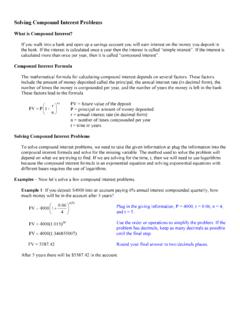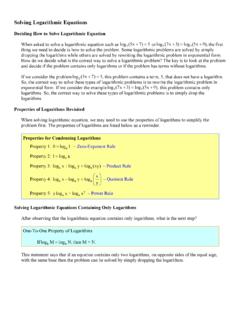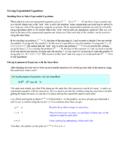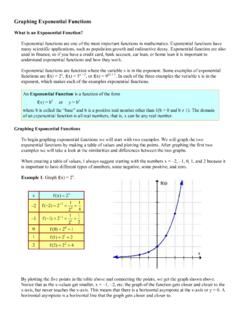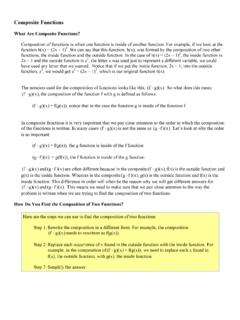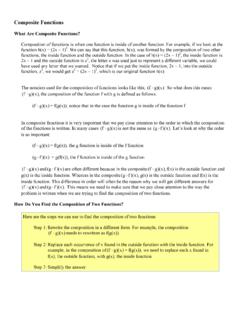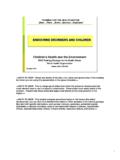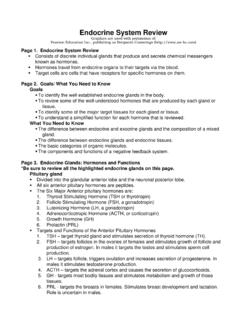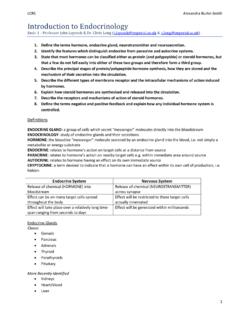Transcription of Chapter 18: The Endocrine System - Mesa Community College
1 Chapter 18: The Endocrine System Chapter Objectives Endocrine GLANDS 1. List the general functions of hormones. 2. List the organs that secrete hormone as their first function and those organs that secrete hormones as a secondary function. HORMONE ACTIVITY 3. Describe how hormones interact with receptor cells. 4. Distinguish between circulating and local hormones. 5. List the hormones that are lipid soluble. 6. List the hormones that are water soluble. MECHANISMS OF HORMONE ACTION 7. Describe the mechanism of action of lipid-soluble hormones. 8. Describe the mechanism of action of water-soluble hormones. HYPOTHALAMUS AND PITUITARY GLAND 9. Discuss the importance of the hypothalamus to pituitary gland function.
2 10. List the seven major hormones secreted by the anterior pituitary gland. 11. Examine the two ways in which secretions of the anterior pituitary hormones are regulated. 12. Discuss the actions of and controls over each of the anterior pituitary gland hormones. 13. Discuss the actions of and controls over each of the posterior pituitary gland hormones. THYROID GLAND 14. Describe the location and histology of the thyroid gland. 15. Explain the actions of thyroid hormones. 16. Describe the formation, storage, and release of thyroid hormones. PARATHYROID GLANDS 17. Describe the location and histology of the parathyroid glands. 18. Discuss the functions of parathyroid hormone. ADRENAL GLAND 19.
3 Describe the location of the adrenal gland and its division into two parts. 20. Describe the three zones of the adrenal cortex and know which hormone is secreted by which zone and the functions of those hormones. PANCREATIC ISLETS 21. Describe the location and histology of the pancreas. 22. List the hormone-secreting cells of the pancreatic islet, the hormones they produce, and the functions of those hormones. 23. Discuss the causes and symptoms of diabetes mellitus. OVARIES AND TESTES 24. Describe the locations, hormones, and functions of the hormones of the gonads. PINEAL GLAND 25. Describe the location, histology, hormones, and functions of the hormones of pineal gland. THYMUS GLAND 26. List the hormones produced by the thymus gland.
4 EICOSANOIDS AND GROWTH FACTORS 27. Explain the actions of eicosanoids. 28. List seven important growth factors. Chapter Lecture Notes The Endocrine System The Endocrine System controls body activities by releasing mediator molecules called hormones Hormones released into the bloodstream travel throughout the body Results may take hours, but last longer Hormones have powerful effects when present in very low concentrations General functions of hormones Help regulate: extracellular fluid metabolism contraction of cardiac & smooth muscle glandular secretion some immune functions growth & development reproduction Endocrine glands (Fig ) Primary function is as Endocrine gland pituitary thyroid parathyroid adrenal pineal Secondary function is as Endocrine gland (Table )
5 Hypothalamus thymus pancreas ovaries testes kidneys stomach liver small intestine skin heart placenta adipose tissue Hormone Receptors Although hormones travel in blood throughout the body, they affect only specific target cells Target cells have specific protein or glycoprotein receptors to which hormones bind Synthetic hormones that block the receptors for particular naturally occurring hormones are available as drugs Circulating and Local Hormones Endocrines (circulating hormones) - hormones that travel in blood and act on distant target cells (Fig ) Local hormones - hormones that act locally without first entering the blood stream Paracrines - hormones that act on neighboring cells Autocrines hormones that act on the same cell that secreted them Chemical Classes of Hormones Lipid-soluble hormones (Table )
6 Steroids thyroid hormones nitric oxide a local hormone in several tissues Water-soluble hormones amines epinephrine norepinephrine melatonin seratonin peptides, proteins, and glycoproteins insulin growth hormone ADH eicosanoids prostaglandins leukotrienes Action of Lipid-Soluble Hormones Lipid-soluble hormones bind to and activate receptors within cells The activated receptors then alter gene expression which results in the formation of new proteins. (Fig ) The new proteins alter the cells activity and result in the physiological responses of those hormones. Action of Water-Soluble Hormones Water-soluble hormones alter cell functions by activating plasma membrane receptors, which set off a cascade of events inside the cell First messenger - the water-soluble hormone that binds to the cell membrane receptor Second messenger a chemical activated inside the target cell Cyclic AMP - a typical second messenger of a water-soluble hormone (Fig ) Some hormones exert their influence by increasing the synthesis of cAMP ADH, TSH, ACTH, glucagon and epinephrine Some exert their influence by decreasing the level of cAMP growth hormone inhibiting hormone (somatostatin)
7 Other substances can act as 2nd messengers calcium ions cGMP PI3 Tyrosine kinase A hormone may use different 2nd messengers in different target cells Hypothalamus and Pituitary Gland The hypothalamus is the major integrating link between the nervous and Endocrine systems Hypothalamus receives input from cortex, thalamus, limbic System & internal organs Hypothalamus controls pituitary gland with releasing & inhibiting hormones Secretion of anterior pituitary gland hormones is regulated by hypothalamic regulating hormones and by negative feedback mechanisms The hypothalamus and the pituitary gland (hypophysis) regulate virtually all aspects of growth, development, metabolism, and homeostasis. The pituitary gland is located in the sella turcica of the sphenoid bone and is differentiated into the anterior pituitary (adenohypophysis), the posterior pituitary (neurohypophysis).
8 ( Fig ) Hormones of the anterior pituitary: (Table & ) Human growth hormone (hGH) Thyroid-stimulating hormone (TSH) Follicle-stimulating hormone (FSH) Luteinizing hormone (LH) Prolactin (PRL) Adrenocorticotrophic hormone (ACTH) Melanocyte-stimulating hormone (MSH) Posterior pituitary gland does not synthesize hormones, but it does store and release two hormones made by the hypothalamus (Table ) oxytocin (OT) antidiuretic hormone (ADH) Also releases regulators of anterior pituitary hormone release made by the hypothalamus Human Growth Hormone and Insulin-like Growth Factors Human growth hormone (hGH) - the most plentiful anterior pituitary hormone Insulin-like growth factors (IGFs) small protein, local hormones that are produced in response to hGH and promote the tissue s response to hGH Target cells liver skeletal muscle cartilage bone Functions.
9 Increases cell growth & cell division increases cellular uptake of amino acids increases synthesis of proteins stimulates triglyceride breakdown (lipolysis) in adipose so fatty acids used for ATP synthesis retards use of glucose for ATP production so blood glucose levels remain high enough to supply brain Release factors from hypothalamus (Fig ) Promotes release - growth hormone releasing hormone (GHRH, somatocrinin) Inhibits release - growth hormone inhibiting hormone (GHIH, somatostatin) Thyroid Stimulating Hormone (TSH) TSH stimulates the synthesis & secretion of T3 and T4 by the thyroid gland Promotes release - thyrotropin releasing hormone (TRH) (Fig ) Inhibits release - growth hormone inhibiting hormone (GHIH, somatostatin) and negative feedback by elevated levels of T3 and T4 Follicle Stimulating Hormone (FSH) FSH functions initiates the formation of follicles within the ovary stimulates follicle cells to secrete estrogen stimulates sperm production in testes Promotes release - gonadotropin releasing hormone (GnRH) Inhibits release - negative feedback by elevated levels of sex hormones Luteinizing Hormone (LH)
10 In females, LH stimulates secretion of estrogen ovulation of 2nd oocyte from ovary formation of corpus luteum secretion of progesterone In males, LH stimulates the interstitial cells of the testes to secrete testosterone Release is mediated by GnRH and negative feedback by sex hormones like FSH Prolactin Prolactin (PRL) works together with other hormones to initiate and maintains milk secretion by the mammary glands Suckling reduces levels of hypothalamic inhibition and prolactin levels rise along with milk production Promotes release - prolactin releasing hormone (PRH) Inhibits release - prolactin inhibiting hormone (PIH, dopamine) Adrenocorticotrophic Hormone Adrenocorticotrophic hormone (ACTH, corticotropin) controls the production and secretion of glucocorticoids (cortisol) by the cortex of the adrenal gland.
